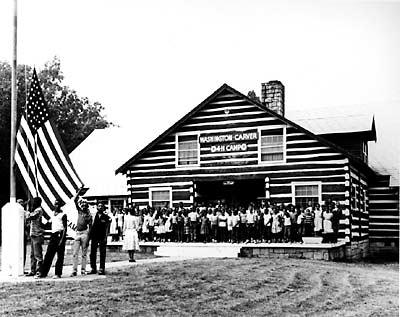Camp Washington-Carver
An African American Landmark in Fayette County
By Norman Jordan
When I moved back to Ansted, Fayette County, in 1979, I realized that it would be hard for me to find suitable employment near my home that would utilize my skills and years of experience as a cultural worker. My most recent job had been as director of a traveling theater company. However, I had heard that the Department of Culture and History, as it was then known, was taking over the old Washington-Carver 4-H camp in Clifftop, just 15 minutes away. Their aim was to turn it into a mountain cultural arts center.
I had never attended the camp as a camper, but I knew that it was the first 4-H camp for African Americans in the country. I had very vivid memories of going to the camp with Ansted residents to play baseball, swim, and have church picnics. Tom Banks, the caretaker at the camp for many years, was from Ansted and he often visited his relatives and friends in our small town. I remember my Dad taking him back to the camp a few times.
 Camp Washington-Carver in Fayette County opened in 1942 as a 4-H camp for African-Americans - the first of its kind in the nation. Photo from the Eastern Coal and Fuel Collection, West Virginia State Archives. |
Sometimes Dad would take me and my brothers and sisters along, and as soon as the car stopped at the camp we would jump out and run around on the grounds and bounce up and down on the saw horse, slide down the sliding board, and – most of all – ride on the merry-go-round. This was a favorite activity with almost all of the young people who spent time at Carver.
Other vivid memories are of the smell of chlorine at the bathhouse and the swimming pool, as well as the happy sounds of swimmers splishing and splashing in the water and diving off the diving board.
I cherish my memories of the times that I spent at Camp Washington-Carver and I feel, as do hundreds of this state's African Americans, that the camp is an important historical landmark. It represents a time when the leaders of our state made serious attempts towards addressing the needs and concerns of the African American citizens.